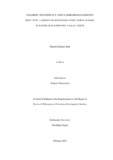
Please use this identifier to cite or link to this item:
https://hdl.handle.net/20.500.14301/152| Title: | TEACHERS’ SELF-EFFICACY AND CLASSROOM MANAGEMENT PRACTICES: A SURVEY OF SECONDARY LEVEL PUBLIC SCHOOL TEACHERS OF KATHMANDU VALLEY, NEPAL |
| Authors: | Shah, Dhurba Bahadur |
| Citation: | Shah,D.B.(2022). Teachers’ self-efficacy and classroom management practices: A survey of secondary level public school teachers of Kathmandu valley, Nepal. |
| Issue Date: | Feb-2022 |
| Publisher: | Kathmandu University School of Education |
| School: | SOED |
| Department: | DODE |
| Level: | Ph.D. |
| Program: | PhD in Development Education |
| Abstract: | Teachers’ self-efficacy (TSE) contributes to improving the quality of education. Highly efficacious teachers tend to make greater efforts in managing a classroom. Despite regular training for public school teachers in Nepal, the effect has not been seen on students’ academic learning and achievement. In this regard, a study of TSE and their classroom management practices (CMPs) was carried out to explore 1) factors contributing to 2) levels of and 3) associations between Nepali TSE and CMPs. The data were collected using Nepali Teachers’ Self-Efficacy (NTSE) and Classroom Management Practices (CMPs) instruments, which were developed using the e-Delphi technique. For this study, 390 secondary-level public school teachers from Kathmandu, Lalitpur, and Bhaktapur were chosen as research participants. The exploratory factor analysis (EFA) was employed to determine the factors contributing to TSE and CMPs. The factors extracted were further validated by confirmatory factor analysis. Descriptive statistics, correlation analysis and structural equation modeling, were other statistical tools employed to analyze the data. The study explored four factors of TSE: efficacy in instructional planning, efficacy in the engagement of students, efficacy in behavioral competency, and efficacy in teaching skills. Likewise, it explored three factors for CMPs: management of processes related to teaching and learning, student management, and group dynamics. The study found that Nepali public-school teachers had high TSE and CMPs. In addition, the findings also demonstrated that there was a positive and significant association between TSE and CMPs. Results also confirmed that TSE affects CMP—teachers with stronger TSE can manage the classroom better. It is established that highly efficacious teachers can effectively manage the classroom. The positive relationship between TSE and their CMPs contributes to improving students learning and achievement. This study implied that teachers’ professional development should be framed, considering the factors contributing to Nepali teachers’ efficacy beliefs and classroom management practices. The study's findings reinforced that teachers with high levels of TSE and CMPs tend to proactively apply and acquire new teaching methodologies and adopt innovative CMP approaches for an effective and empowering classroom environment. The efficacious teachers combined with effective CMPs promote positive outcomes for schools, such as students’ achievement and learning. The study also discussed that in addition to teachers being highly efficacious and effective at CMPs, there might be other structural factors such as physical infrastructures, contemporary curriculum, climate friendly classrooms, and influence-free socio-political situations that contribute to bringing tangible improvement in the quality of public school education in Nepal. |
| URI: | https://hdl.handle.net/20.500.14301/152 |
| Appears in Collections: | Theses |
Files in This Item:
| File | Description | Size | Format | |
|---|---|---|---|---|
| WCC- Final Thesis_TSE and CMPs (Dhurba B Shah) V7 02202023.pdf | 3.64 MB | Adobe PDF |  View/Open |
Items in DSpace are protected by copyright, with all rights reserved, unless otherwise indicated.